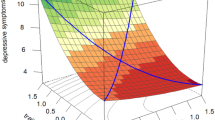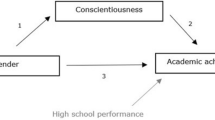Abstract
This study explored whether trait competitiveness in late adolescence is more detrimental to females’ than males’ social and psychological adjustment. Two types of competitiveness were studied, competing to win (CW; to dominate others) and competing to excel (CE; to surpass personal goals). Questionnaire ratings (by self and others) of 110 (53 females, 57 males, Mage 17.9 years) predominantly Caucasian (88.9%) high school students in northern Texas, USA were gathered. Males were higher on CW than females, but there were no gender differences on CE. For females, CW was associated with greater depression and loneliness, and with fewer and less close friendships. CE was associated with higher self-esteem and less depression for both genders, but was largely unrelated to social adjustment.

Similar content being viewed by others
References
Abramson, L., Seligman, M., & Teasdale, J. (1978). Learned helplessness in humans: Critique and reformulation. Journal of Abnormal Psychology, 87, 49–74.
Achenbach, T. M., & Edelbrock, C. S. (1983). Manual for the child behavior checklist and revised child behavior profile. Burlington: University Associates in Psychiatry.
Adams, G., & Jones, R. (1983). Female adolescents’ identity development: Age comparisons and perceived child-rearing experience. Developmental Psychology, 19, 249–256.
Adler, A. (1927). The theory and practice of individual psychology. New York: Harcourt, Brace, and World.
Bakan, D. (1966). The duality of human existence. Chicago: Rand McNally.
Bandura, A. (1977). Self-efficacy: Toward a unifying theory of behavioral change. Psychological Review, 84, 191–215.
Bem, S. (1974). The measurement of psychological androgyny. Journal of Consulting and Clinical Psychology, 42, 155–162.
Benenson, J. F., Roy, R., Waite, A., Goldbaum, S., Linders, L., & Simpson, A. (2002). Greater discomfort as a proximate cause of sex differences in competition. Merrill-Palmer Quarterly, 48, 225–247.
Brown, L. M., & Gilligan, C. (1992). Meeting at the crossroads: Womens’ psychology and girls’ development. New York: Ballantine.
Buhrmester, D. (1992). Network of relationship questionnaire—relationship quality version. Unpublished manuscript, University of Texas at Dallas, Richardson TX.
Buhrmester, D. (1996). Need fulfillment, interpersonal competence, and the developmental contexts of early adolescent friendship. In W. M. Bukowski, A. F. Newcomb, & W. W. Hartup (Eds.), The company they keep: Friendship in childhood and adolescence (pp. 158–185). New York: Cambridge University Press.
Burton, L., Hafetz, J., & Henninger, D. (2007). Gender differences in relational and physical aggression. Social Behavior and Personality, 35, 41–50.
Buss, D., & Schmitt, D. (1993). Sexual strategies theory: An evolutionary perspective on human mating. Psychological Review, 100, 204–232.
Chen, X., Zappulla, C., Coco, A., Schneider, B., Kaspar, V., De Oliveira, A., et al. (2004). Self-perceptions of competence in Brazilian, Canadian, Chinese and Italian children: Relations with social and school adjustment. International Journal of Behavioural Development, 28, 129–138.
Corcoran, K., & Fisher, J. (1987). Measures for clinical practice: A sourcebook. New York: Collier Macmillan.
Costrich, N., Feinstein, J., Kidder, L., Marecek, J., & Pascal, L. (1975). When stereotypes hurt: Three studies of penalties for sex-role reversals. Journal of Experimental Social Psychology, 11, 520–530.
Crick, N. R. (1996). The role of overt aggression, relational aggression, and prosocial behavior in the prediction of children’s future social adjustment. Child Development, 67, 2317–2327.
Crick, N. R. (1997). Engagement in gender normative versus nonnormative forms of aggression: Links to social-psychological adjustment. Developmental Psychology, 33, 610–617.
Crick, N. R., & Grotpeter, J. K. (1995). Relational aggression, gender, and social-psychological adjustment. Child Development, 66, 710–722.
Crick, N. R., & Grotpeter, J. K. (1996). Children’s treatment by peers: Victims of overt and relational aggression. Development and Psychopathology, 8, 367–380.
Crick, N., & Rose, A. (2000). Toward a gender-balanced approach to the study of social-emotional development: A look at relational aggression. In P. H. Miller & E. Kofsky Scholnick (Eds.), Toward a feminist developmental psychology (pp. 153–168). Florence: Taylor & Frances/Routledge.
Davis, M. H. (1983). Measuring individual differences in empathy: Evidence for a multidimensional approach. Journal of Personality and Social Psychology, 44, 113–126.
Franken, R. E., & Brown, D. J. (1996). The need to win is not adaptive: The need to win, coping strategies, hope and self-esteem. Personality and Individual Differences, 20, 805–808.
Furman, W., & Buhrmester, D. (2009). The network of relationships inventory: Behavioral systems version. International Journal of Behavioural Development, 33, 470–478.
Griffin-Pierson, S. (1990). The competitiveness questionnaire: A measure of two components of competitiveness. Measurement and Evaluation in Counseling and Development, 23, 108–115.
Harter, S. (1990). Adolescent self and identity development. In S. Feldman & G. Elliott (Eds.), At the threshold: The developing adolescent (pp. 352–387). Cambridge: Harvard University Press.
Hartup, W. (1992). Peer relations in early and middle childhood. In V. B. Van Hasselt & M. Hersen (Eds.), Handbook of social development: A lifespan perspective (pp. 257–281). New York: Plenum Press.
Helgeson, V. S. (1994). Relation of agency and communion to well-being: Evidence and potential explanations. Psychological Bulletin, 116, 412–428.
Helgeson, V. S., & Fritz, H. L. (1999). Unmitigated agency and unmitigated communion: Distinctions for from agency and communion. Journal of Research in Personality, 33, 131–158.
Hibbard, D. R., & Buhrmester, D. (1998). The role of peers in the socialization of gender-related social interaction styles. Sex Roles, 39, 185–202.
Hofstede, G. (1980). Culture’s consequences. Beverly Hills: Sage.
Horner, M. (1972). Toward an understanding of achievement-related conflicts in women. Journal of Social Issues, 28(2), 157–175.
Houston, J. M., McIntire, S. A., Kinnie, J., & Terry, C. (2002). A factorial analysis of scales measuring competitiveness. Educational and Psychological Measurement, 62, 284–298.
Jarvinen, D. W., & Nicholls, J. G. (1996). Adolescents’ social goals, beliefs about the causes of social success, and satisfaction in peer relations. Developmental Psychology, 32, 435–441.
Kalakoski, V., & Nurmi, J. (1998). Identity and educational transitions: Age differences in adolescent exploration and commitment related to education, occupation, and family. Journal of Research on Adolescence, 8(1), 29–47.
Knox, M., Carey, M., & Kim, W. (2003). Aggression in inpatient adolescents: The effects of gender and depression. Youth & Society, 35, 226–242.
Koenig, L. J., & Abrams, R. F. (1999). Adolescent loneliness and adjustment: A focus on gender differences. In K. J. Rotenberg & S. Hymel (Eds.), Loneliness in childhood and adolescence (pp. 296–322). New York: Cambridge University Press.
Kohn, A. (1992). No contest: The case against competition. Boston: Houghton Mifflin.
Kovacs, M. (1981). Rating scales to assess depression in school-aged children. Acta Paedospychiatrica, 46, 305–315.
Kroger, J., & Green, K. (1996). Events associated with identity status change. Journal of Adolescence, 19, 477–490.
Lever, J. (1978). Sex differences in the complexity of children’s play and games. American Sociological Review, 43, 471–483.
Loeber, R., & Stouthamer-Loeber, M. (1998). Development of juvenile aggression and violence: Some common misconceptions and controversies. The American Psychologist, 53, 242–259.
Maccoby, E. E. (1990). Gender and relationships: A developmental account. The American Psychologist, 45, 513–520.
Maccoby, E. E., & Jacklin, C. N. (1974). The psychology of sex differences. Stanford: Stanford University Press.
Marcia, J. (1966). Development and validation of ego identity status. Journal of Personality and Social Psychology, 3, 551–558.
Marcia, J. (1976). Identity six years after: A follow-up study. Journal of Youth and Adolescence, 5, 145–150.
Mathur, R., & Berndt, T. J. (2006). Relations of friends’ activities to friendship quality. Journal of Early Adolescence, 26, 365–388.
Nurmi, J. (2004). Socialization and self-development: Channeling, selection, adjustment, and reflection. In R. M. Lerner & L. Steinberg (Eds.), Handbook of adolescent psychology, 2nd ed (pp. 85–124). Hoboken: John Wiley & Sons Inc.
Pollack, S., & Gilligan, C. (1982). Images of violence in Thematic Apperception Test stories. Journal of Personality and Social Psychology, 42, 159–167.
Rose, A., & Rudolph, K. (2006). A review of sex differences in peer relationship processes: Potential trade-offs for the emotional and behavioral development of girls and boys. Psychological Bulletin, 132, 98–131.
Rosenberg, M. (1965). Society and the adolescent self-image. Princeton: Princeton University Press.
Rosenkrantz, P., Vogel, S., Bee, H., Broverman, I., & Broverman, D. H. (1968). Sex-role stereotypes and self-concepts in college students. Journal of Consulting and Clinical Psychology, 32, 287–295.
Rudman, L. (1998). Self-promotion as a risk factor for women: The costs and benefits of counter stereotypical impression management. Journal of Personality and Social Psychology, 74, 629–645.
Rudman, L., & Glick, P. (1999). Feminized management and backlash toward agentic women: The hidden costs to women of a kinder, gentler image of middle managers. Journal of Personality and Social Psychology, 77, 1004–1010.
Russell, D. W. (1996). UCLA Loneliness Scale (Version 3): Reliability, validity, and factor structure. Journal of Personality Assessment, 66, 20–40.
Ryckman, R. M., Hammer, M., Kaczor, L. M., & Gold, J. A. (1990). Construction of a hypercompetitive attitude scale. Journal of Personality Assessment, 55, 630–639.
Ryckman, R. M., Thorton, B., & Butler, J. C. (1994). Personality correlates of the Hypercompetitive Attitude Scale: Validity tests of Horney’s theory of neurosis. Journal of Personality Assessment, 62, 84–94.
Ryckman, R. M., Hammer, M., Kaczor, L. M., & Gold, J. A. (1996). Construction of a personal development competitive attitude scale. Journal of Personality Assessment, 66, 374–385.
Ryckman, R. M., Libby, C. R., van den Borne, B., Gold, J. A., & Lindner, M. A. (1997). Values of hypercompetitive and personal development competitive individuals. Journal of Personality Assessment, 69, 271–283.
Ryckman, R. M., Thorton, B., Gold, J. A., & Burckle, M. A. (2002). Romantic relationships of hypercompetitive individuals. Journal of Social and Clinical Psychology, 21, 517–530.
Ryska, T. A. (2001). Self-esteem among intercollegiate athletes: The role of achievement goals and competitive orientation. Imagination, Cognition and Personality, 21, 67–80.
Schneider, B. H., Woodburn, S., del Pilar Soteras del Toro, M., & Udvari, S. J. (2005). Cultural and gender differences in the implications of competition for early adolescent friendship. Merrill-Palmer Quarterly, 51(2), 163–191.
Seligman, M. E. P. (1991). Learned optimism. New York: Knopf.
Spence, J. T., Helmreich, R. L., & Holahan, C. K. (1979). Negative and positive components of psychological masculinity and femininity and their relationships to self-reports of neurotic and acting out behaviors. Journal of Personality and Social Psychology, 37, 1673–1682.
Sullivan, H. S. (1953). The interpersonal theory of psychiatry. New York: Norton.
Tassi, F., Schneider, B. H., & Richard, J. F. (2001). Competitive behavior at school in relations to social competence and incompetence in middle childhood. Revue Internationale de Psychologie Sociale, 14, 165–184.
Thompson, E., & Pleck, J. (1995). Masculinity ideologies: A review of research instrumentation on men and masculinities. In R. F. Levant & W. S. Pollack (Eds.), A new psychology of men (pp. 129–163). New York: Basic Books.
Underwood, M. K. (2003). Social aggression among girls. New York: Guilford Press.
Wentzel, K. (2005). Peer relationships, motivation, and academic performance at school. In A. J. Elliot & C. S. Dweck (Eds.), Handbook of competence and motivation (pp. 279–296). New York: Guilford Publications.
Zarbatany, L., McDougall, P., & Hymel, S. (2000). Gender-differentiated experience in the peer culture: Links to intimacy in preadolescence. Social Development, 9, 62–79.
Author information
Authors and Affiliations
Corresponding author
Rights and permissions
About this article
Cite this article
Hibbard, D.R., Buhrmester, D. Competitiveness, Gender, and Adjustment Among Adolescents. Sex Roles 63, 412–424 (2010). https://doi.org/10.1007/s11199-010-9809-z
Published:
Issue Date:
DOI: https://doi.org/10.1007/s11199-010-9809-z




